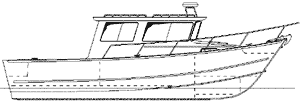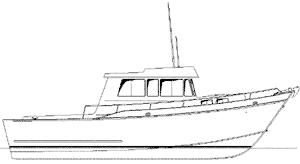|
Designing
the Great Alaskan 26
by Brian Dixon
go
on to Part 2 - Detailed Designs
PART I - Initial Design Considerations
Background:
I'm an engineer working for a big blue chip company as a color science specialist designing digital projectors in R&D. I also love boats. In particular, I love offshore planing hulls the most. They are the boat that most closely supports what I like to do …offshore fishing (and boat camping). Something that I've always wanted to get into is boat design, possibly designing and producing plans for fun during retirement. Since retirement is only 20 years away for me and I survived my mid-life crisis, I decided to start down the road of learning to design. I did some research and chose the Westlawn professional yacht design program. There are other schools available of course, but Westlawn is entirely done through 'distance learning' techniques (mail, email, phone) and worked well with my day job and family requirements. After making it about halfway through the program (with high grades), which included my real goal …high speed planing hulls, I realized that most of the rest of the program covered material that I wasn't as interested in, sailboat design and manufacturing materials and methods for example. I postponed, at least for now, the program and switched to studying the greats in planing hull design. Lindsay Lord, DuCane, Savitsky, Stoltz, and others.
Not predicting that I was going to start on a design for a larger boat soon, I also began building a boat that I knew about and had high respect for, the Tolman Jumbo (22' offshore sea skiff with cabin). It seemed fairly ideal for my uses. The boat includes a lot of features that I highly respect in an offshore boat (for a skinflint like myself). It has modest deadrise, much like the famous Calkins Bartender, flared dory-style sides for lots of reserve buoyancy, rugged yet light composite (stitch-n-tape) construction, and finally, the thing that I admired the most: a rock solid reputation among those who would use the boat as I do, offshore. Rumor has it that it got more than twice the fuel efficiency that similarly sized commercial offerings did and all owners consistently describe how well the boat operates, with safety, in seas from all directions. That was the boat for me. Halibut and tuna here I come!
Introducing the Great Alaskan 26 (GA-26):
Knowing from conversations with lots of folks, I knew that a larger boat along the same lines as the Tolman (for usage, safety, efficiency) was desired by many but not really available. I mean, there are other boat designs available of course, but it seemed that they always had a downside. For example, time-consuming and more expensive ply-on-frame construction etcetera. Tracy O'Brien's 26' Alfred W. Davis is of course available, but there just wasn't a lot of choice out there for composite-construction offshore planing hulls in sizes above 22' to 24'. I wanted to design a larger offshore planing hull that would be both attractive, have a lot of the Tolman characteristics, but still be uniquely mine. But what good would designing such a boat be if I couldn't afford the time or money to build the boat myself? I needed a prototype and someone to build it. Enter Dave Nolan of New Jersey. Dave previously built a Tolman Widebody (a stretched version), regularly fished offshore to 80 or 90 miles out, and wanted a bigger boat designed for this use. The Widebody is an amazing boat, but it was not designed to travel the better part of a hundred miles offshore. Suddenly, my hen scratchings and early design work on a 26 footer had reason to become a real boat.
Initial Design:
The list of features that the boat should have is not long, and it's fairly straight forward. I wanted the boat to be of composite construction, be trailerable (else few folks will want to build it), be efficient to operate, and have the proper set of features for safety offshore. In addition, I wanted the boat to have classic styling and wanted it to be a flexible design able to carry a variety of cabins and possibly to be built over a range of sizes. The boat should be commensurate with other 26' boats in the world, which means it should cut water in a reasonably nice manner and have a reasonably comfortable manner.
In particular, the boat should incorporate several features that give it safety offshore (as much as can be had for a boat of this style and size). In particular, the boat needs some symmetry. First, the amidships waterline beam should be wider than the waterline beam aft and the bow fullness should be such that it helps balance the stern yet still cuts water acceptably. The center of lateral resistance should be at or aft of the longitudinal center of gravity (LCG), and the center of flotation (CF) should be forward of the LCG. Of course the center of buoyancy (LCB), LCG, and CF should be where they belong according to accepted design practices for normal (not racing) boats. If these goals are met, then the boat should prove to resist broaching when in a steep following sea, yet drive into a head sea reasonably well. The center of lateral resistance and hull symmetry helps avoid broaching, while the narrowed stern and symmetry together help maintain maneuverability and lets the bow rise up head seas without undue resistance from the stern.
If the boat has a moderate deadrise, no more than necessary, and a reasonable half-angle of entry then the boat should operate efficiently. Since weight is efficiency's worst enemy, if the boat weighs less yet still exceeds strength requirements then that will help efficiency too. And finally, if the planing area of the hull (aft sections) form a true monohedron, e.g. a prismatic hull, then that will both help the boat plane and will additionally result in more efficient water flow.
Finally, noting that this boat should be a stable safe fishing platform and also a good cruiser, I had to select appropriate stability factors that would meet both goals. A quantified measure of a boat's transverse (roll) stability at rest or moving slowly is the transverse metacentric height (GMt). The GMt is often used to indicate a boat's relative initial stability (first 10-15 degrees of heel). A higher GMt indicates higher stiffness. For example, a block of Styrofoam floating on the water responds instantly to waves as they pass by, keeping it's surface parallel to the changing water at all times. But a large wooden dowel (round) fails to respond at all other than moving vertically up and down with wave height. These are two extremes, but the foam block has a much higher GMt than the cylinder. The naval architect that I hired for the purpose of validating and checking the design of the Great Alaskan 26 stated that the GMt for a boat in this size range should be in the 30" to low-40" range, certainly not lower than 24". The 22' Tolman Jumbo has a metacentric height (light ship loading) of 55". A "stable" platform is more like the cylinder. It would stay level no matter what. But fishing boats are often drifted over fishing grounds or trolled very slowly. Compromising safety by not allowing the boat to respond to the seas is out of the question. On the other hand, there is no compelling reason why a metacentric height must be higher than what the Tolman Jumbo of strong reputation has. I selected a GMt target range to be 45" to 55" for the GA-26. When non-keeled boats are loaded heavily (large cargo load or heavy cabin and outfitting), the GMt lowers. I certainly did not want to produce a boat that would compromise the GMt too much when loaded heavily (as Dave will surely do, with hundreds of pounds of ice and fish), hence the lower limit of 45". It is likely that if the boat is loaded heavily that the GMt could be reduced to the upper-thirties (still quite acceptable according to what other boats have and what my naval architect consultant stated.) So much for statical stability for slow moving fishing vessels. The boat also needs to have good dynamic stability, which means it does not exhibit transverse ('chine walking') or longitudinal ('porpoising') instability when on plane over the range of speeds that the boat should be able to operate over.
To put the icing on the cake, the boat should have appropriate freeboard throughout, a classic bow good for keeping water out of the boat, and as much semi-dory flare in the sides as I could squeeze in for good reserve and ultimate stability. The area under the righting arm (GZ) curve and the degrees of roll which the boat can withstand without capsizing should be as high as possible without compromising other design trade-offs. This is where the freeboard and flare combination come in. I also chose to follow the American Boat and Yacht Council (voluntary) "Standards & Technical Information Reports for Small Craft", also known as the 'ABYC Standards'. Same goes for the US Coast Guard (USCG) standard wherever they apply. Unfortunately, unless I manufacture the boat myself, there is much that is left to the builder to get right (wiring, fuel and bonding systems, final cabin design, etcetera). And since there is some contradiction in the various standards, e.g. deck height above water for self-draining decks and the associated drain rates, it would not actually be possible to meet all requirements. Some judgment is necessary on my part and on the part of the builder. I provide recommendations and issue liberal warnings on various options that the builder may go with, e.g. large open decks are an invitation for capsize due to free surface moments induced by volumes of water getting in the boat. It's better to put a cabin on the boat that sheds water over most of the boat's length, and to take steps to prevent down flooding (below deck flooding) and for water removal (panic + bucket is not enough, although it is a reliable response.)
With these concepts in mind, I set out to do a customer survey to find out what folks of like mind (like mine that is) would prefer in the way of cabins, type of sheer line, etcetera. I went to the Yahoo Tolman Builder's group and put up a poll. I found that for this type of boat, that most preferred a classic sheer …in fact, they seemed to prefer a fairly good upsweep to the sheerline forward such as you'd see on a traditional Maine lobster boat or on a Nova Scotia style fishing boat. Nobody wanted a flat, mild classic, or powderhorn style sheer that you see on so many boats nowadays. For cabins, people seemed to be split between a work-boat-ish cabin with forward leaning windshields and more traditional and stylish cabins with aft leaning windshield. In addition, I assumed that some folks would prefer a semi-traditional light cabin so they could have maximum work (or recreation) space aft. The following three profiles are what I came up with. Note that at this time, the boat is most optimized for a cabin similar to the Down-Easter shown below, but with hard sides on both sides and longer wheel house length. In other words, the design is currently optimized for a moderate cabin that is neither super light weight nor heavy. After sea trials and dockside tests are complete, this will be yet another topic to review later on before plans are released to the public (sometime in Fall of 2005).

Figure 1) The Northwestern - click images for larger view

Figure 2) The Down-Easter

Figure 3) The Grand Banks
go
on to Part 2 - Detailed Designs
|

